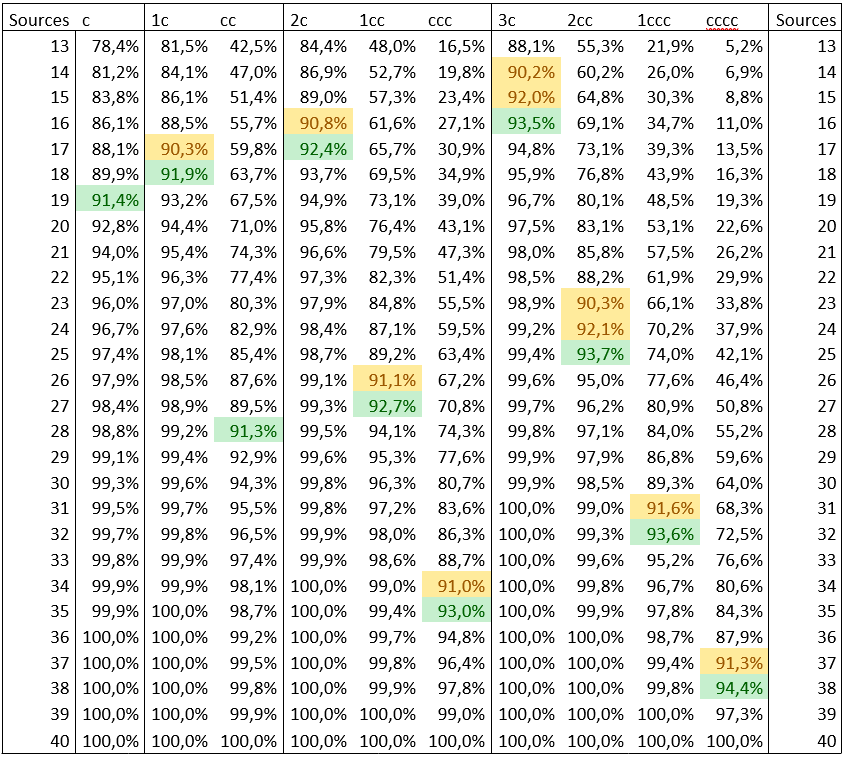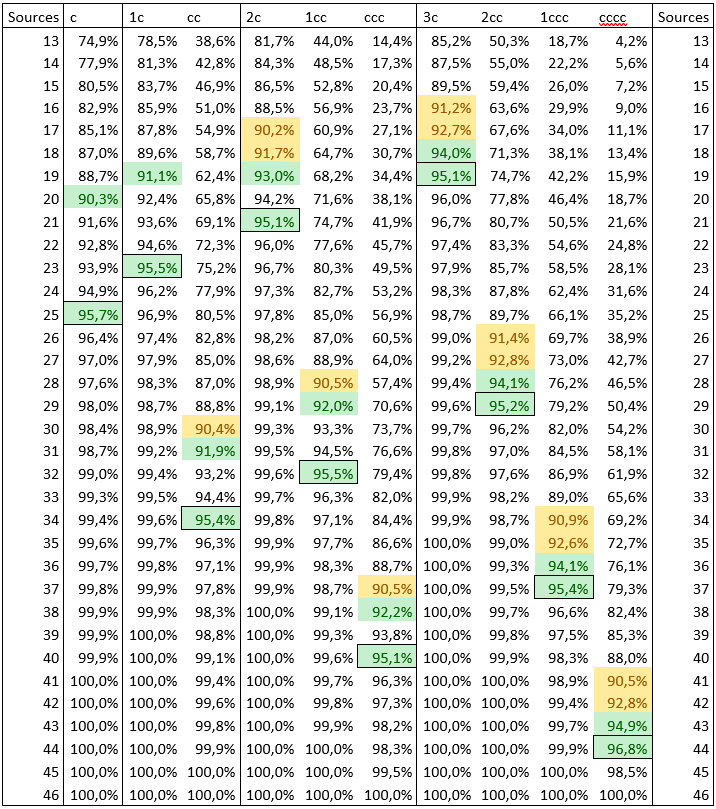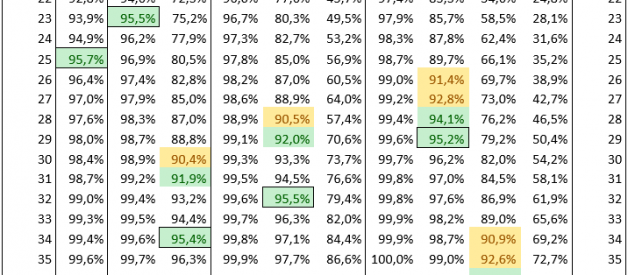When asking how many lands you need in a Commander deck, most people work by rule of thumb. This article takes a more mathematical approach. At first, I wanted to be lazy and just use the great work of Frank Karsten[1][2]. It is however not optimized for (casual) multiplayer Commander. My calculations differ in two assumptions from his. I considered the free mulligan. Since this allows for more greedy mulligans, I changed the mulligan strategy as well. This leads to fewer lands being required and overall better chances of hitting your landdrops. The downside is that you have to mulligan more. If you want to play around with the numbers or have a better look at my calculations here is the link to the Excel Sheet.
How many Lands do you need?
I will lead of with some general assumptions. People might tell me how vastly different commander decks might be. However, most want to cast their Commander and play a longer game than Modern or Legacy decks. Many popular commanders cost 4 mana. Six of the top ten Commanders on EDHREC cost 4mana, only one costs less. I assume you want to get 4 mana on turn 4 with 90% or higher probability. Also, some of the better draw spells are available on 4 mana (Greater Good, Fact or Fiction effects, Concentrate effects). These are only the minimum requirements. Having enough mana to cast your commander does not mean you have the right colors or good cards in hand. If you really want to be 90% sure, both the chance of having enough land and the chance of having the right colors need to be about 95% (0,95=0,9025). Additionally, many commander decks want to cast cards that cost 6 or more mana. I do not want to make any calculations for that. I can however tell you that chances of hitting your land drops decline after the 4th land[3]. Ramp and card draw are much better tools than running even more lands.
I made some calculations using Excel. 40 lands can get you a 90% probability of hitting 4 lands turn 4. If you want to be extra safe 46 lands are required. An interesting finding is that you have to mulligan 7-card hands that contain only two lands. This leads to more Mulligans but a much better chance to hit your land drops. Not doing so you would need 47 lands just to have a 90% chance. Hands with 6 or less cards and 2 lands can be kept since scrying toward lands increases your success. I did neither consider your chances after mulligans to less than 5 cards, nor the chances with bad 5-card hands (0,1,5 lands). The chance that you mulligan down to those is quite rare. Additionally, even when hitting land drops you probably lose anyway. My mulligan rules are the following:
- You mulligan any 7-card hand with 0, 1, 2, 6, or 7 lands.
- You mulligan any 6-card hand with 0, 1, 5, or 6 lands.
- If you have a 5-card hand with 0, 1, or 5 lands you probably failed anyway.
- After a mulligan, you scry a land to the top and a spell to the bottom, if you have less than 4 lands in hand.

How to get this many lands?
Forty-six is a high number. There are some ways to play less lands while effectively having the same amount of lands. These are: Land Search, Non-Land Ramp, Cantrips and Card Selection/Card draw.
When I count my lands, I use the following formula. Note that the cards should be able to be cast before turn 4. Thus, they should cost less than 4 mana. Steep color requirements like Sign in Blood in a 3 color deck are also problematic. Furthermore, a 3 mana Commander like ?Tymna, the Weaver? blocks the 3 mana slot, so you cannot count these cards either.
Land Search is counted as a full land. This includes typical green ramp like Rampant Growth as well as some other effects like Tithe.
Non-Land mana sources are counted as 0.75 mana source. They are more likely to be hit by removal. This category includes mana rocks such as Sol Ring or Signets, mana dorks like elves or birds of paradise as well as Land Tax. I usually see Wayfarers bauble as unsafe since I like to play it turn one and thus make it vulnerable to cards like Fragmentize.
Card Selection here means anything that lets you dig deeper than one card, be it via draw or via scry. Preordain and Faithless Looting are a way to sculpt your hand. Cards like Mulldrifter and Night?s Whisper draw you cards thus increasing the chance to see more lands.
Cantrips are cards that replace themselves while offering a minor effect. They will be counted as 1/3 of a mana source. This is because I assume to have at least 33 lands, thus drawing a card will yield a land with 33% probability. Cards from that category that are Gitaxian Probe, Crash Through, Quicken or Scout?s Warning. It is probably useful to count Ponder and Brainstorm as simple cantrips as well. Although, they enable card selection, without a way to shuffle you will still draw the same cards. The density of fetchlands is much lower in Commander. Even with ten fetchlands the probability to see one in the first ten cards (turn 3) is about 67%. You need 7 fetchlands to get the probability above 50%. And you still need additional blue mana to cast the cantrip.
An Example Deck: Ephara
Let?s look at one of my decks. I showcase my Ephara Deck[4] since it has a variety of different mana sources. The commander costs 4 mana, no surprise here.
Lands and Land Search: 36 Lands + Tithe
37
Unsafe sources: Deranged Assistant, Land Tax, Azorius Signet, Fellwar Stone, Mind Stone, Sol Ring, Talisman of Progress, Thought Vessel, Wayfarer?s Bauble, Land Tax. I also count Sunscape Familiar since casting Ephara is the important part. I do not count Mana Drain and Warping Wail since I see them more as rituals and they are also hard to cast.
+8,25 (11*0,75)
Card Selection: Preordain
+0,5
Cantrips: Wall of Omens, Gitaxian Probe, Ponder, Brainstorm, Scout?s Warning
+1,67 (5*1/3)
= 46,92
I did not consider Trinket Mage (who finds Sol Ring), Myriad Landscapes ramp ability, Sensei?s Divining Top or Temple of Enlightenments Scry 1.
As you can see this deck has an effective number of lands above 46, although I am only running 36 lands. This can lead to mistakes. As a more experienced player I often get asked how many lands I run. You cannot just copy someones landcount. Their deck might not have the same amount of ramp or card selection.
How many colored sources do you need?
Here I will present some more general information on how many colored mana sources you need in order to cast your spells reliably. The calculations always look at the cases where you have drawn sufficient lands and considers the probability of having the right ones among them. The calculations are somewhat simplified. I did not change the numbers of cards in the deck dependent on the number of mulligans. This is a small change, however.
I have calculated the odds for both 40 and 46 land decks. I marked the numbers for a 90% chance as well as some slightly higher numbers if you want to increase your certainty with the mana cost. For the 46 land version, I also highlighted the numbers for a 95% chance.
Here are the numbers for the 40 land deck:

And here is the 46 land version:

Time to take another look on my Ephara Deck. There are some spells I would like to cast turn one. Brainstorm, Ponder and Preordain in Blue and Tithe or Land Tax in white. To do that with 90%+ certainty I would need 20 untapped sources for either color. Well, the deck only has 18 sources for each (counting Gemstone Cavern), which pulls the reliability down to 87%. What would I need to change? Three more fetchlands are possible. Also, some taplands could be replaced by basics. I could also go competitive and add two moxen. Port town is an option as well.
On turn two I can cast almost anything. In addition to all the sources I could use turn one, now taplands and filter lands can be used, giving my 4 additional mana sources. Counterspell and Mana Drain would require at least 30 blue sources which is utopian in a deck that also wants to cast Land Tax turn one. Rather than add Mana Confluence and other painful fixing, I will wait to cast these later.
The colorless sources are another topic. I run 7 lands that tap for colorless as well as Gemstone Caverns and Myriad Landscape which both might be used otherwise. Thus, I assume 8 lands. There are 4 mana rocks that that provide colorless mana, Deranged Assistant and Trinket Mage who will probably get Sol Ring first. So, there are 8 Safe plus 6 unsafe sources. This puts me at about 13 sources at turn 3 or later. Warping Wail is not reliably castable on turn 2, with only 8 sources. This makes me question its inclusion. It is a decent removal/counterspell, and a cantrip with Ephara out. I think I overestimate its potential to turbo out turn 3 Ephara. Casting Thought-Knot-Seer off 4 mana is about 85% reliable. Usually I cast him after Ephara, thus the requirements are slightly lower. Getting double colorless to really abuse Eldrazi Displacer is probably hard. During play I was quite happy with all those cards, but the variance is high in Commander and I think I once had more utility lands.
You may have noticed that I did not account for Card Selection and Cantrips in this calculations. The problems is I can only use them when I already have the colored mana which is kind of a catch 22. This sure is pessimistic, but it is a reasonable assumption and keeps unwarranted greed in check. Furthermore they might compete for the turn two mana with my colorless mana rocks which I need to cast before colorless spells.
What have we learned here? Getting both colors reliably turn one is difficult. As is paying for double color costs like Counterspell or Mana Drain on turn two. In general, building a reliable mana base is not trivial. The showcased deck was not even a budget build.
Another Example Deck: Budget Atraxa
I built a budget Atraxa landbase to showcase what to do with the data. I did not test this deck, nor do I play an Atraxa deck. I just used this example since Atraxa is most popular on EDHrec.
Sadly, there is not an easy way to calculate the odds for multicolored spells. Let?s assume you want to cast Atraxa. So, you need one mana of each of your colors on turn 4, so you look at the numbers for 3c spells. Additionally, you need 4 rightly colored mana in total, so you look at the cccc spells. Now you need all this at the same time and the numbers are not independent, especially when there are cards like command tower in your deck. Frank Karsten estimated that an increasing the requirements by one does yield good results. He however considered casting two colored spells in 60 card standard decks. This is guesswork, but I would at least increase the requirements by one for each color more than one your deck has. So, I would increase the requirements by 3 in our hypothetical Atraxa deck. Let?s say you want to play Atraxa on turn 4 with 90% reliability. You first need 95% reliability to get 4 lands, thus you play 46 mana sources. Now, you want the right colors with 95% reliability. This leads to 22 (19+3) sources being required for each color. A good rule of thumb is that on average your mana sources should produce 2 colors (22*4/46). Furthermore, all your sources should produce colored mana, since colorless cannot be used to cast your commander. As a side note, Sol Ring is probably still good but should not counted here since it does not help you cast Atraxa. I have typed in the mana base bellow:
Land (38)
1x Adarkar Wastes
1x Brushland
1x Caves of Koilos
1x Command Tower
1x Darkwater Catacombs
1x Drowned Catacomb
1x Exotic Orchard
9x Forest
1x Glacial Fortress
1x Hinterland Harbor
2x Island
1x Isolated Chapel
1x Llanowar Wastes
1x Nimbus Maze
1x Path of Ancestry
2x Plains
1x River of Tears
1x Sungrass Prairie
1x Sunpetal Grove
2x Swamp
1x Underground River
1x Vivid Creek
1x Vivid Grove
1x Vivid Marsh
1x Vivid Meadow
1x Woodland Cemetery
1x Yavimaya Coast
Non-Land (9)
1x Cultivate
1x Farseek
1x Kodama?s Reach
1x Rampant Growth
1x Azorius Signet
1x Dimir Signet
1x Fellwar Stone
1x Orzhov Signet
1x Sakura-Tribe Elder
You have 22 green sources as well as Exotic Orchard, which is probably a green source 80% of the time. This allows you to cast the green ramp spells with high reliability (~95%). 16 lands produce white, 17 produce blue and 16 produce black. There are five green ramp spells which I count as a full mana source as well as 4 mana rocks which I count as 0,75 sources. For colors I count Fellwar Stone and Exotic Orchard together as one source of any color. The vivid lands are counted as a source of any color. The weird duals (River of Tears, Nimbus Maze) and filter lands are also considered full sources for each of their colors. Using these assumptions, this deck has 46 mana sources. 23,25(16lands+0,95*5+1+0,75*4) white and black sources, 24,25 blue sources and 23 green sources. There are only 5 lands that always enter the battlefield tapped. This should get you an Atraxa with 90% probability on turn 4 or earlier. As a tradeoff you cannot reliably cast non-green spells early.
I hope this article helps you develop your mana bases. Writing this has helped me think about my decks and make some small changes. For example my 5 color control deck has more green sources now. At last, I want to thank the friends that commented, proofread and encouraged me for this article.
Latest edit: I changed the title, since it was confusing Mana Sources and Lands.
Tldr:
Play at least 40 mana sources, 46 is probably a good number.
Mulligan any 7 card hand with 2 lands and no way to get more.
Your average multicolored deck does not play double color spells like Counter Spell/Mana Drain on turn two.
You need 19 green sources to cast your rampant growth with 90% reliability. Play 23 to be 95% safe!
Your 4 color decks? mana sources should produce two colors on average.


